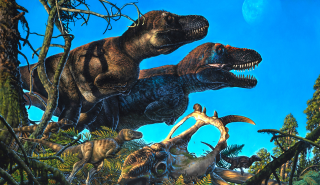Study Reveals Dinosaurs Defied Temperature-Size Rule
Mammals and dinosaurs that lived in cooler climates were not bigger than extinct animals that lived in warmer temperatures, a new study has shown.
The findings challenge a long-held ecological belief – known as Bergmann’s rule – that predicts that warm-blooded animals that reside in colder climates in higher latitudes will be bigger than those that reside in warmer climates below the equator.
The new study, published today (Friday, 5 April) in Nature Communications, shows that the longstanding rule falls apart when considering extinct species. Data from fossil records and climate models show that extinct mammals and dinosaurs (including extinct birds) did not get bigger with cooling temperatures.
Dr Jacob Gardner, a postdoctoral researcher at the University of Reading who co-authored the study, said: “Dinosaurs and mammals originated at the start of the Mesozoic Era more than 230 million years ago when global temperatures were much warmer. These two groups spread to every corner of the Earth, with dinosaurs diversifying into a wider range of sizes — from small flying birds to some of the largest terrestrial animals to exist.
“Our study shows that the size of dinosaurs and mammals didn’t just depend on where they lived. We found that Bergmann’s rule only works for some warm-blooded animals, like modern birds, and only when you look at temperature alone, ignoring other climate factors like rainfall or humidity. This suggests that Bergmann’s ‘rule’ is more of an exception than a rule.”
Birds getting bigger?
The scientists also used computer models to study the body sizes of living and extinct birds. Although the study found no link between where extinct birds lived and their size, when they looked specifically at the effect of temperature, they did discover that modern bird size is influenced by temperature.
While modern birds tend to be slightly larger in colder environments, this was not the case for birds that lived alongside the non-avian dinosaurs. This finding suggests that the influence of temperature on bird size is a relatively recent phenomenon. The researchers think this difference might be connected to recent climate change and the evolution of migratory birds, which often travel long distances between breeding and wintering grounds.
The study also highlighted that fossils are an often overlooked but valuable resource in ecological research. More than 99% of all species that have ever existed are now extinct, but many scientists choose to focus only on studying patterns in modern ecosystems. By incorporating fossil data, scientists can gain a more complete understanding of how life on Earth has evolved and adapted over millions of years.

